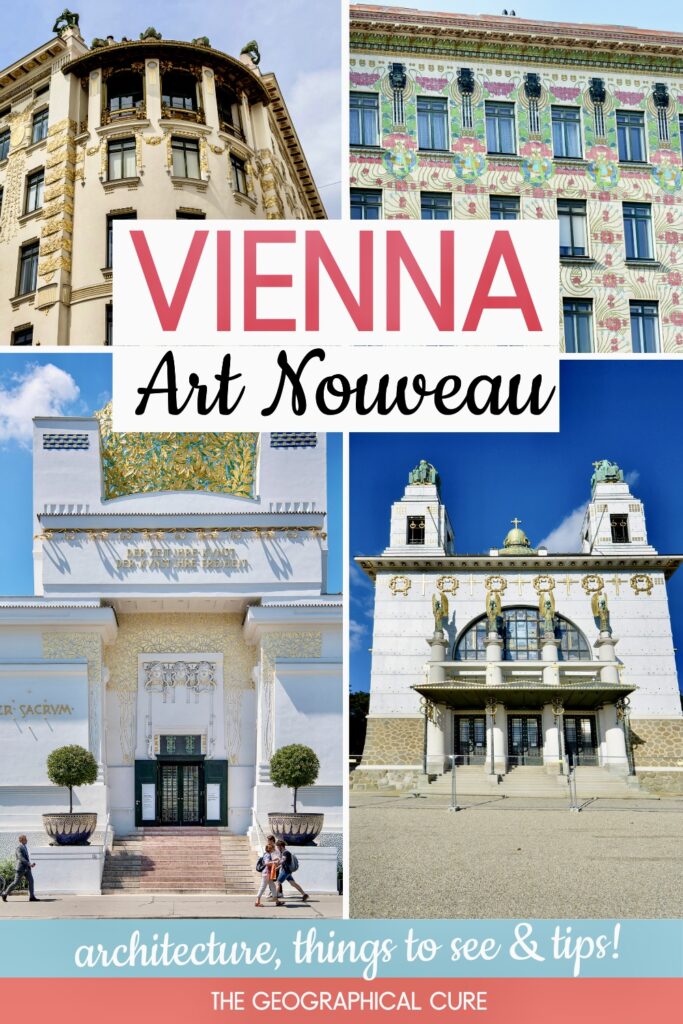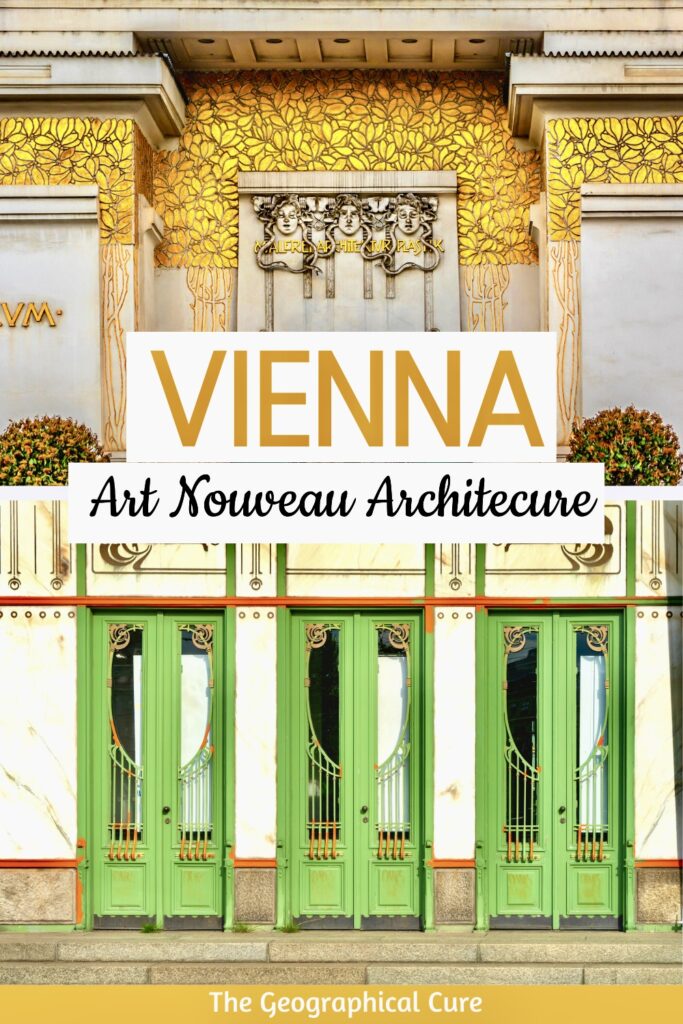If you love Art Nouveau like I do, Vienna is the city for you! The entire cityscape is dotted with eye-catching architecture from the turn-of-the-century.
In this article, I take you on a tour of Vienna’s Art Nouveau architecture and discover what sets these buildings apart. The best works strike a balance between geometric rigor and a more sensual line with frequent use of gold.
One way to see them in an efficient fashion is to book an Art Nouveau walking tour. I took this 3 hour guided tour the last time I was in Vienna and it was fantastic!
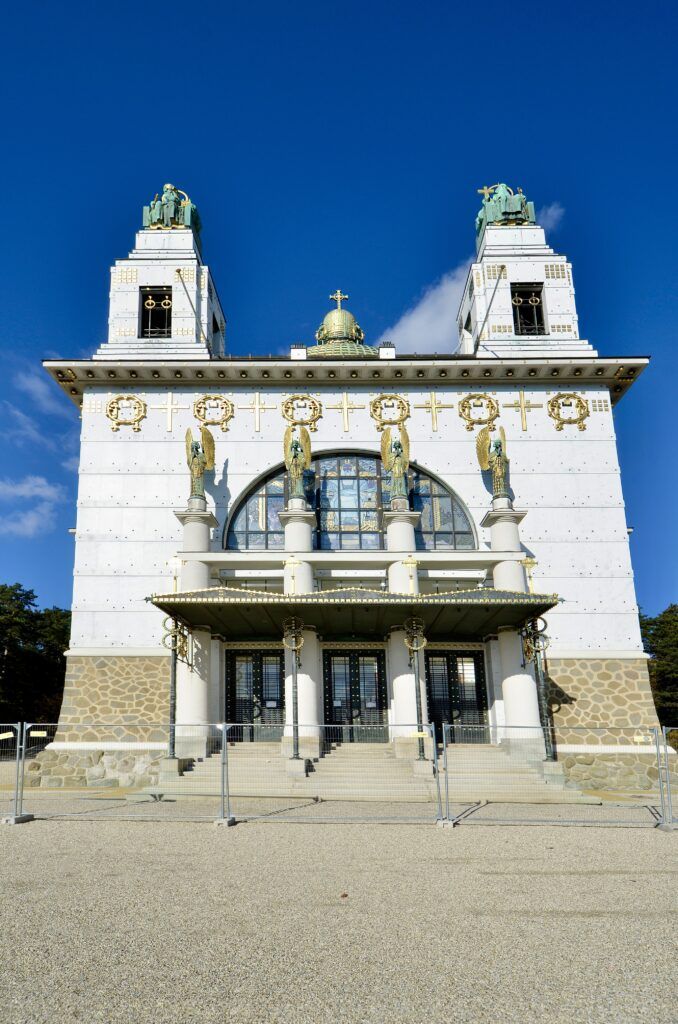
Art Nouveau In Vienna
Church of St. Leopold
Renowned architect Otto Wagner’s masterpiece is the Church of St. Leopold, a true highlight of Vienna’s Art Nouveau architecture. This church stands out with its striking use of copper and marble, a signature style of Wagner.
The structure is composed of white marble and glazed tiles, giving it a bright and pristine look. You’ll also notice elegant gold Art Nouveau elements, including laurel wreaths, in both geometric and floral patterns. Four angels with golden wings stand beneath a gilded-iron cupola.
Inside, the church is just as impressive. It boasts beautiful mosaics and stained glass windows. They’re the work of Koloman Moser, another Secession artist.
A notable renovation in 2005 included the addition of 5 pounds of gold leaf to the copper dome, re-enhancing its splendor.
Tip: Reaching the church can be a bit tricky. It’s possible to use a combination of tram and bus or the U-Bahn and bus. But for simplicity and convenience, you might prefer taking a taxi.
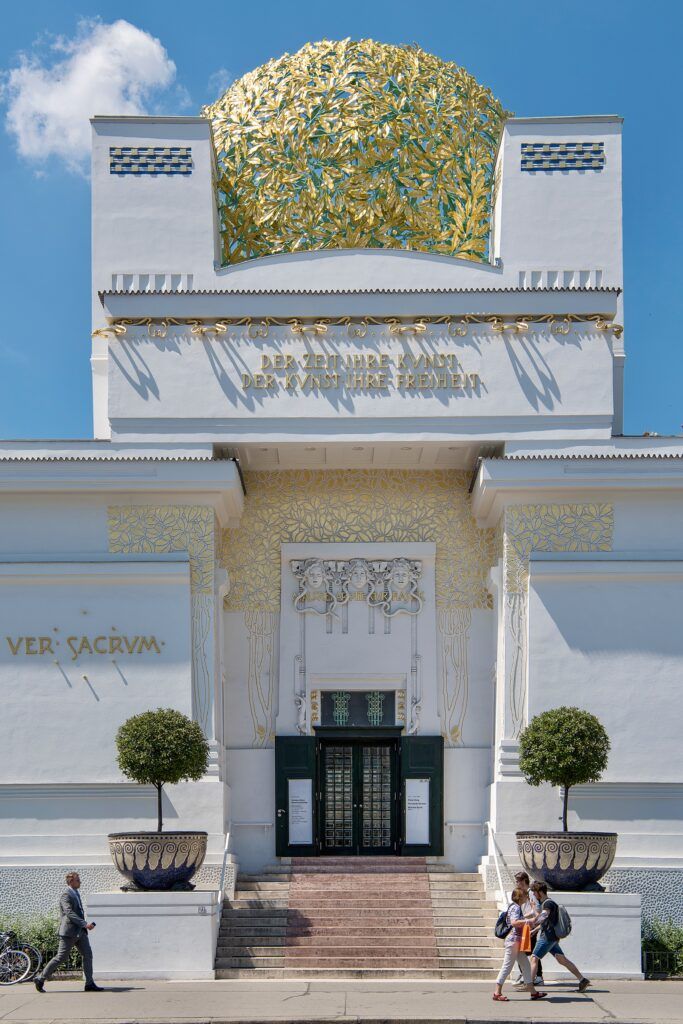
Secession Museum
Josef Olbrich, a student of Otto Wagner, designed the Secession building, a striking example of Art Nouveau architecture in Vienna. It’s a minimalist yet bold design.
Blending elements of a temple and a cult site, the building is blindingly white and windowless. Its entrance bears the inscription “Der Zeit ihre Kunst. Der Kunst ihre Freiheit,” meaning “To every age its art. To every art its freedom.”
The building’s most notable feature is its golden, laurel-decorated dome. Despite its simplicity, the building includes some Art Nouveau decorative elements.
The entrance is guarded by Medusa-like masks symbolizing the three arts – painting, architecture, and sculpture – and is meant to ward off evil. Gold floral motifs and sculptures of mythological figures Theseus and the Amazon also frame the entrance.
Initially, the Viennese were skeptical of the design, dubbing the building a “mausoleum” and the dome “the golden cabbage.” Today, however, it’s a beloved icon of the city.
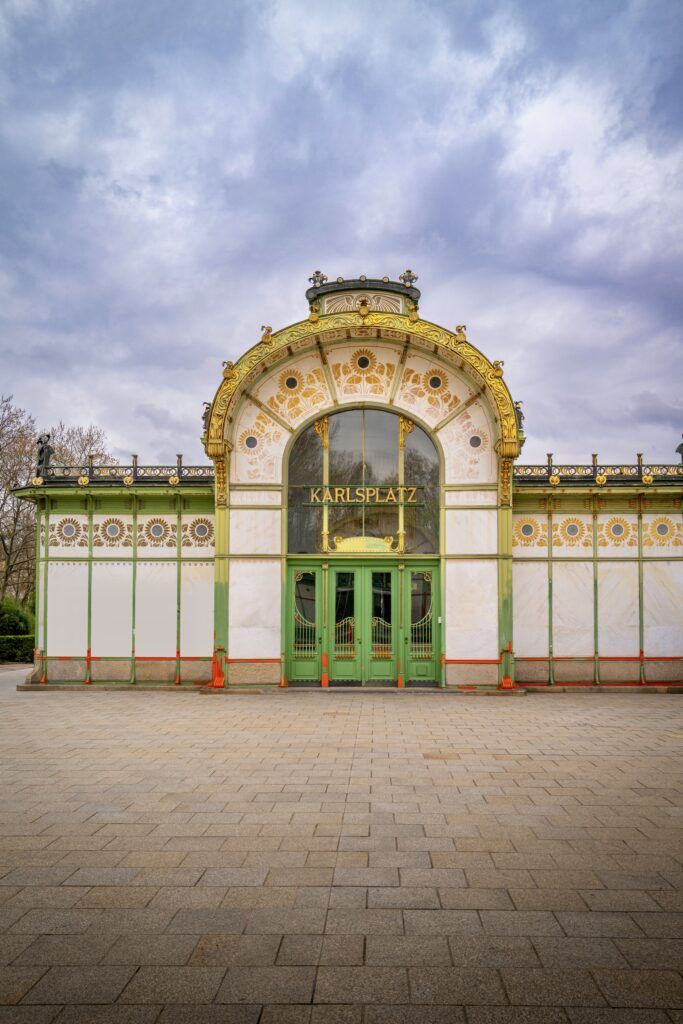
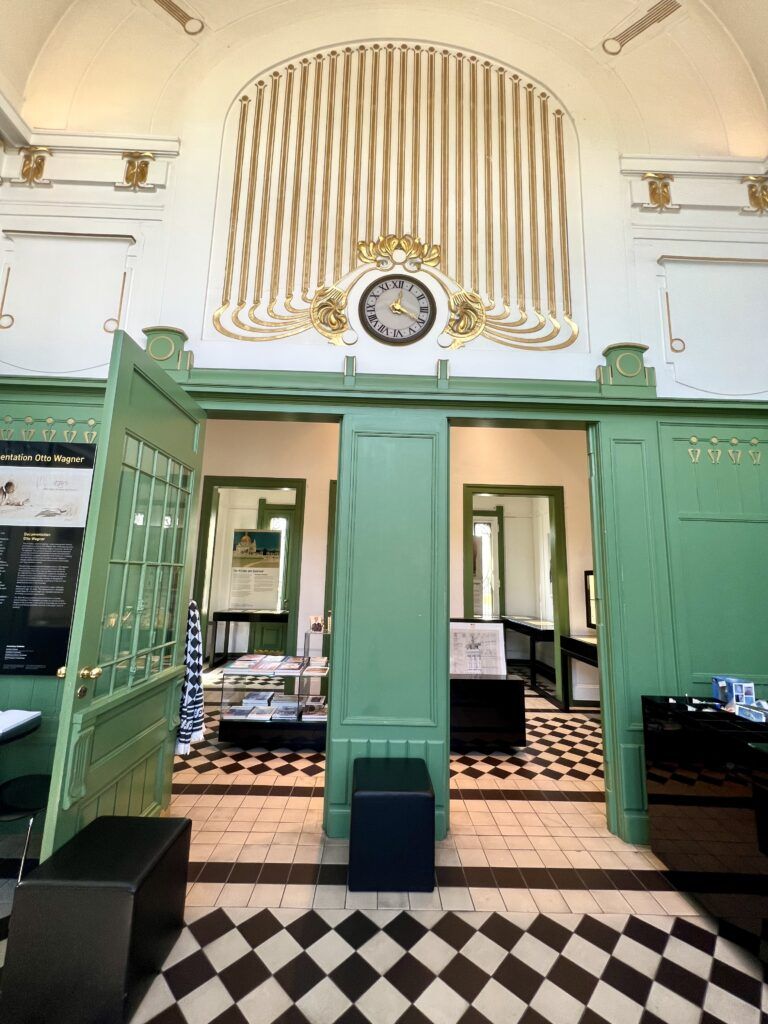
Otto Wagner Pavilions
At the northern edge of Karlsplatz, you will find two station buildings designed by Wagner.
Built in 1898, these pavilions were part of Wagner’s work on the Stadtbahn, Vienna’s urban rail system. Today, one houses a small museum and the other a small cafe.
The pavilions are renowned for their detailed, ornamental designs typical of the Jugendstil movement. This includes elegant, flowing lines and organic forms.
The pavilions have an iron frame hung with marble slabs. The white marble contrasts with gold floral motifs.
Tip: Wagner also designed the Stadtpark station and it’s quite similar in style to these pavilions.
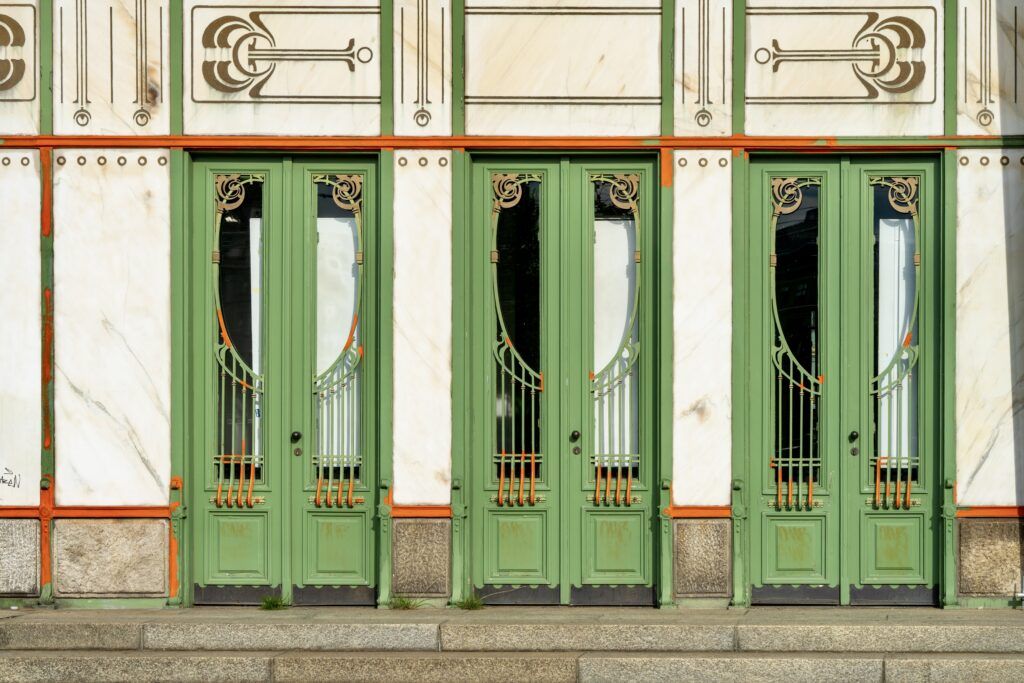
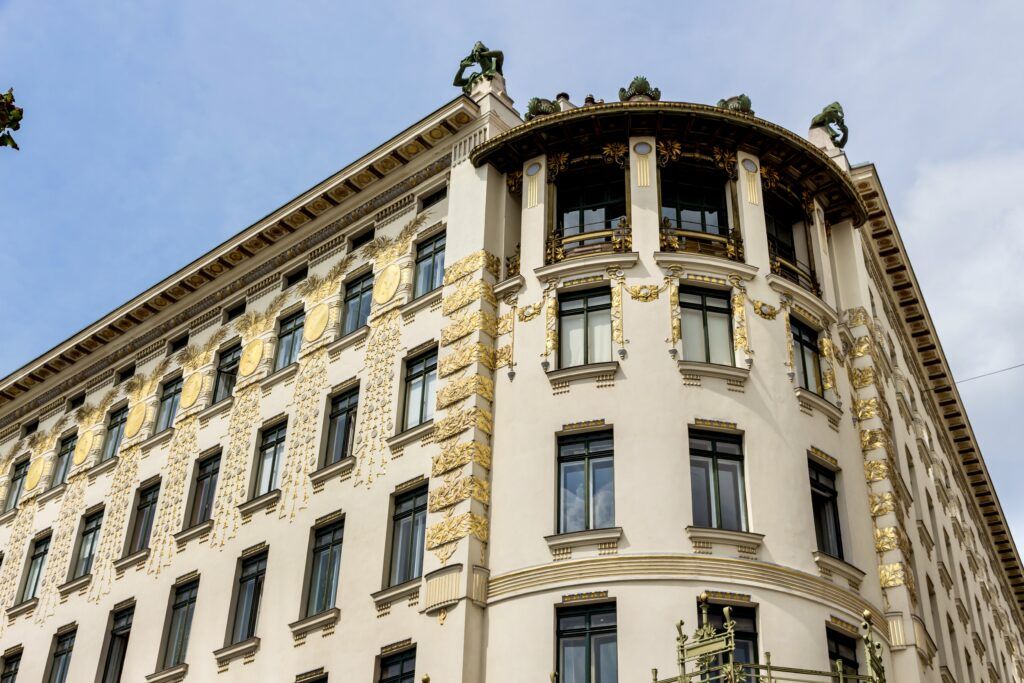
Wienzeile Houses
Designed by Wagner, the Weinzeile Houses are prime examples of Viennese Art Nouveau architecture.
Located along the Naschmarkt on the Wienzeile, these buildings stand out for their elaborate facades, vibrant colors, and intricate details.
These white and gold house at #38 reflects Wagner’s philosophy of combining functionality with artistic beauty. The rounded off point between the walls is an exquisite pavilion, crowned with sculptures of two women shouting.
Wagner’s use of gold leaf, gold medallions, and ornamental figures makes the structure a visual delight. Koloman Moser designed the medallions and palmettes on the magnificent cornice.
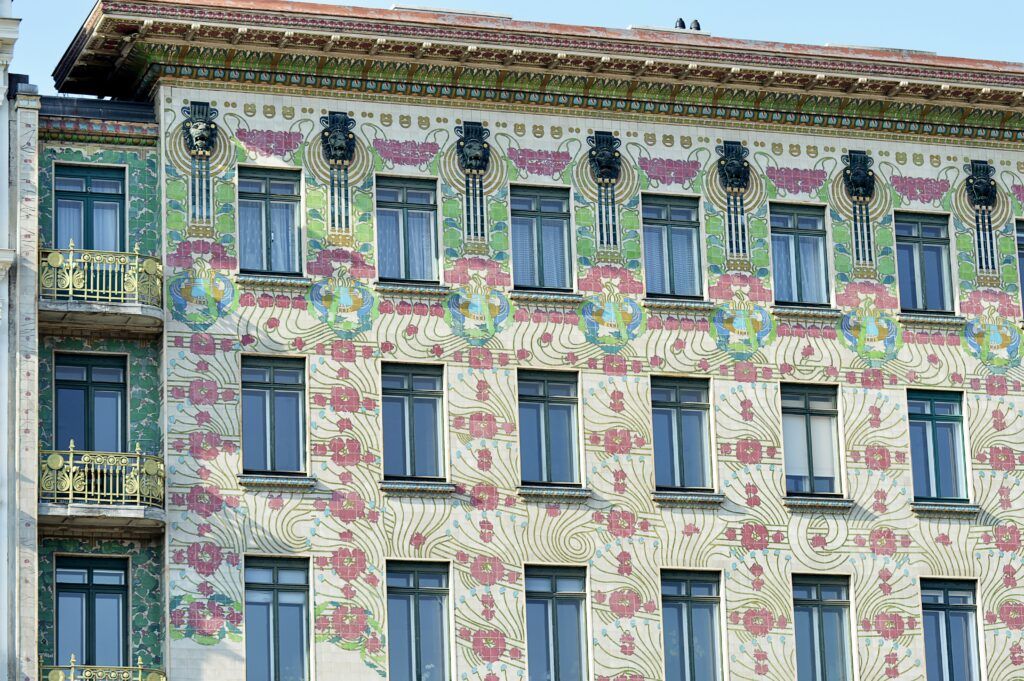
Majolica House
The Majolica House, located at #40 on the Wienzeile, is arguably one of Wagner’s most stunning creations. The building catches the eye with its two sets of receding windows on either side.
But what really sets the Majolica House apart is its vibrant use of majolica tiles. These tiles are richly decorated with a variety of motifs, ranging from intricate floral patterns to geometric shapes and stylized decorations.
Not only do these tiles add a splash of color and beauty to the building, but they also serve a practical purpose: they’re weather-resistant. Using majolica was extremely innovative in Viennese architecture at the time.
Adding to its charm is the intricate ironwork, a signature element in Vienna’s Art Nouveau architecture. You can see this beautiful metalwork in details like the balcony railings.
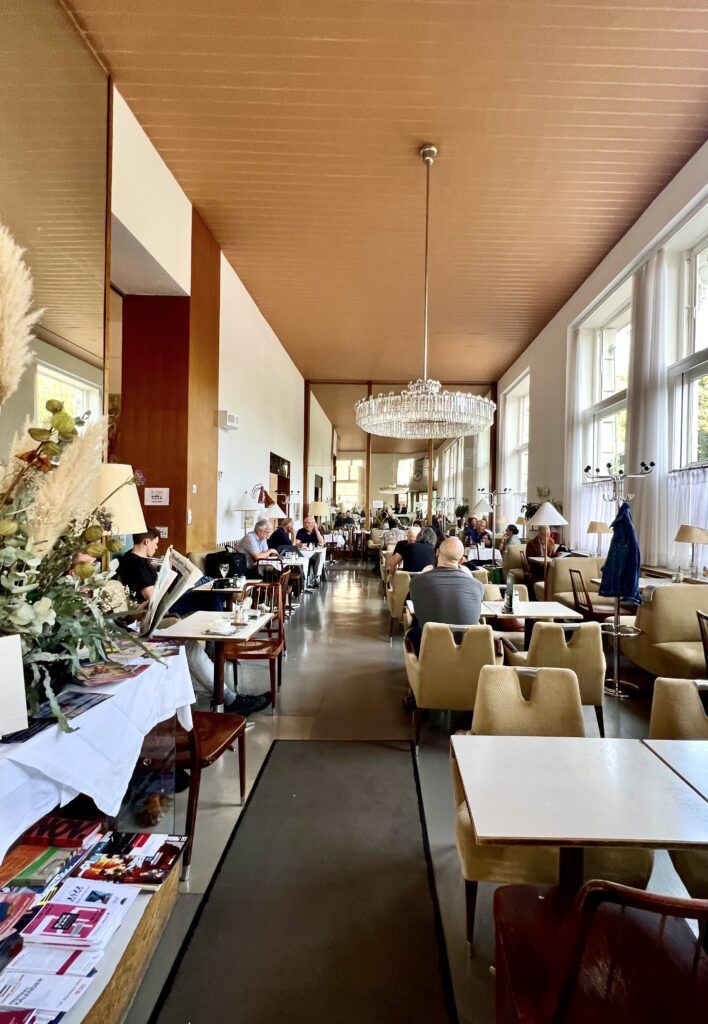
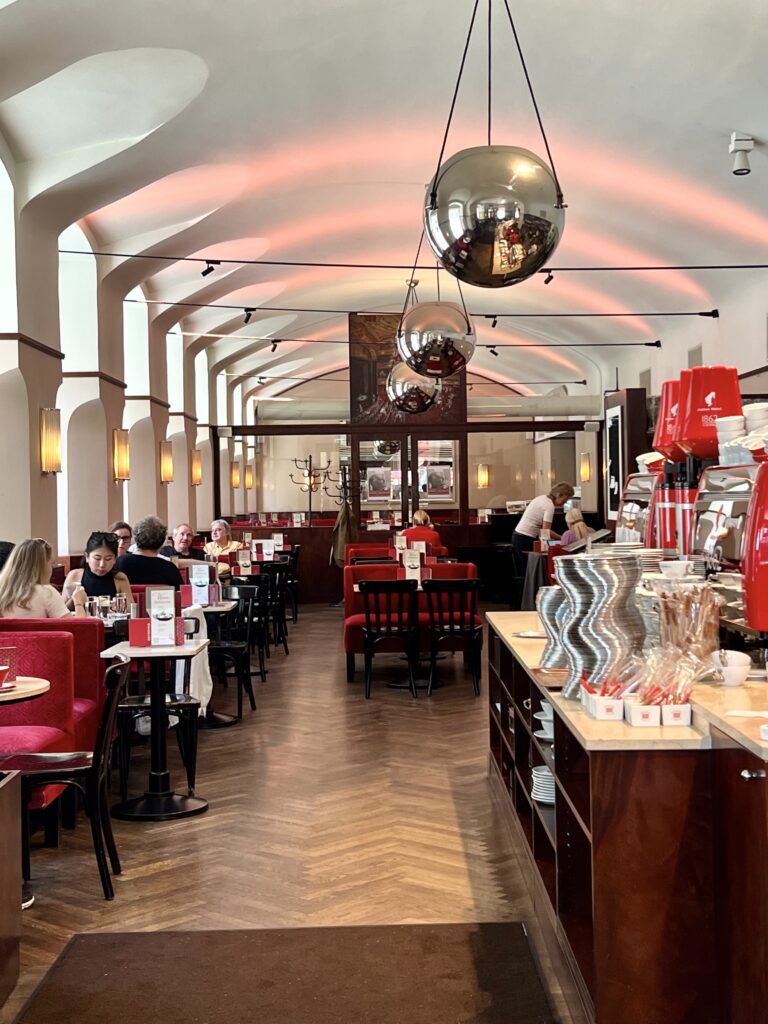
Cafe Museum & Cafe Pruckel
Adolf Loos, known for his minimalist and modernist architecture, influenced the interior design of Café Prückel. It’s since been renovated.
But the architect’s emphasis on simplicity and functionality can still be seen in the cafe’s streamlined shape and soft furnishings in pale colors.
Located near the Secession Museum, the Cafe Museum was also a Loos design. It was once a popular meeting place for composers and creative types.
Loos rejected the traditional push interiors that were then in vogue. The minimalist cafe has mirrors, red-stained beech furniture, and simple geometric globes for lighting.
The cafe’s 1930s interior caused a sensation when it was unveiled and was nicknamed “Cafe Nihilism.”
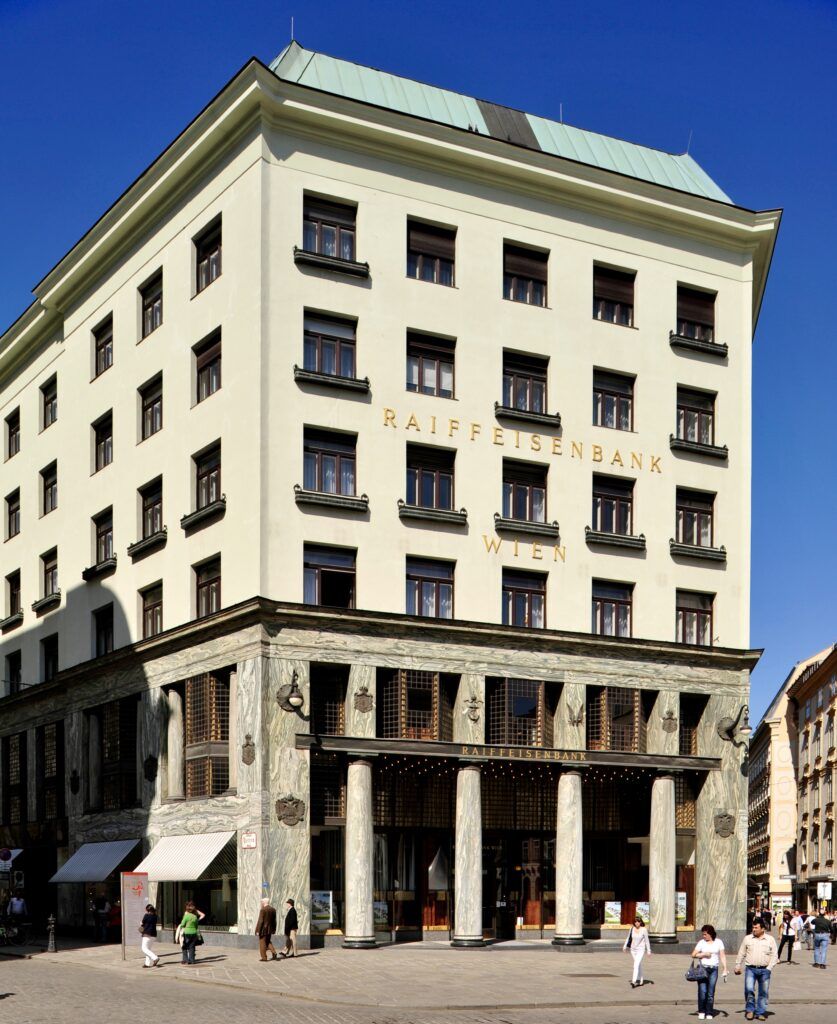
Loos House
You can’t miss the Loos House. Designed by Adolf Loos, it’s right in front of the Hofburg Palace on Michaelerplatz. It was built in 1912 for the renowned men’s tailor Goldman & Salatsch.
Its design features a clean, grid-like exterior with rows of square windows and balconies set against polished stone. The entryway is marked by a portico with luxurious cipollino marble columns.
Its minimalistic facade initially drew criticism from traditionalists who nicknamed it “the house without eyebrows.”
There’s even a story that Emperor Franz Joseph disliked the building so much that he would close his windows to avoid seeing it.
Over the years, the Loos House has served various purposes, including a stint as a bank. Currently, it stands vacant, with its future use undecided.
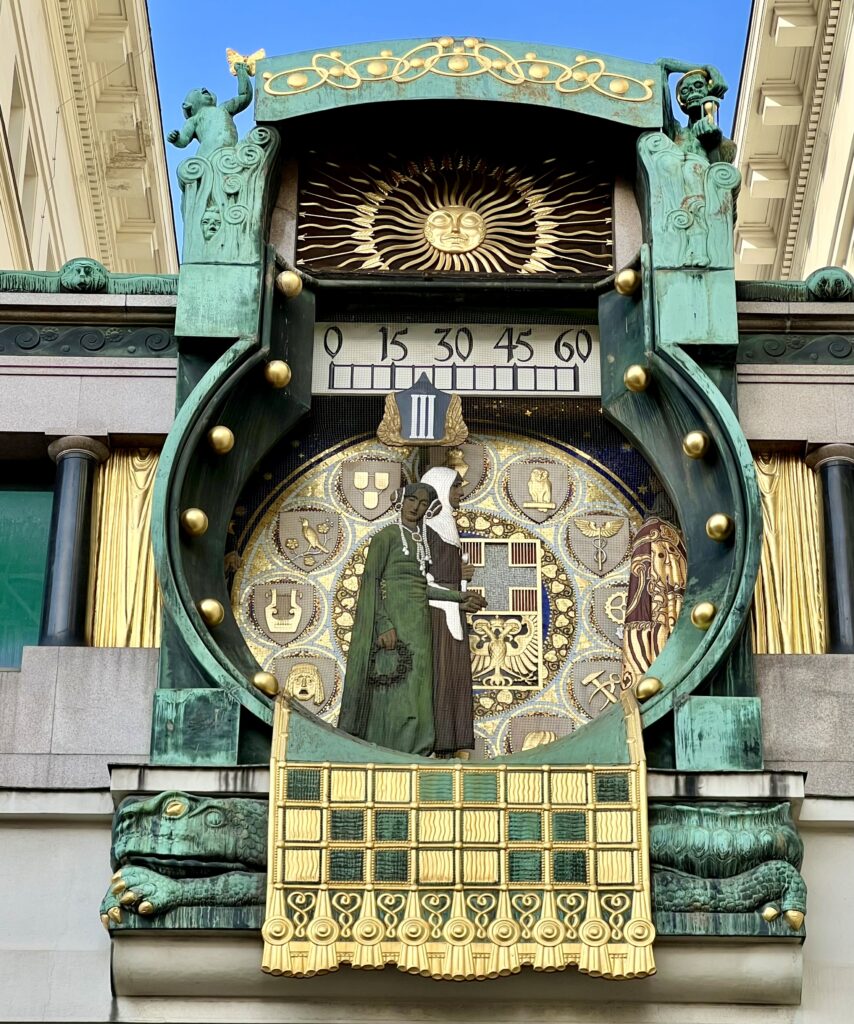
Anker Clock
The Ankeruhr, a large and ornate clock, is a prominent public timepiece in the heart of Vienna’s city center at Hoher Markt.
Painter and sculptor Franz von Matsch designed this striking gold and green clock between 1911 and 1914.
On its face, the clock displays a stunning mosaic featuring twelve historical figures, each symbolizing an hour of the day.
These figures gracefully move across the clock face daily, marking the passage of time. Among them, you can spot notable personalities like Leopold VI and his wife.
Crowning the top of the clock are eye-catching sculptures of a baby and death, each holding an anchor.
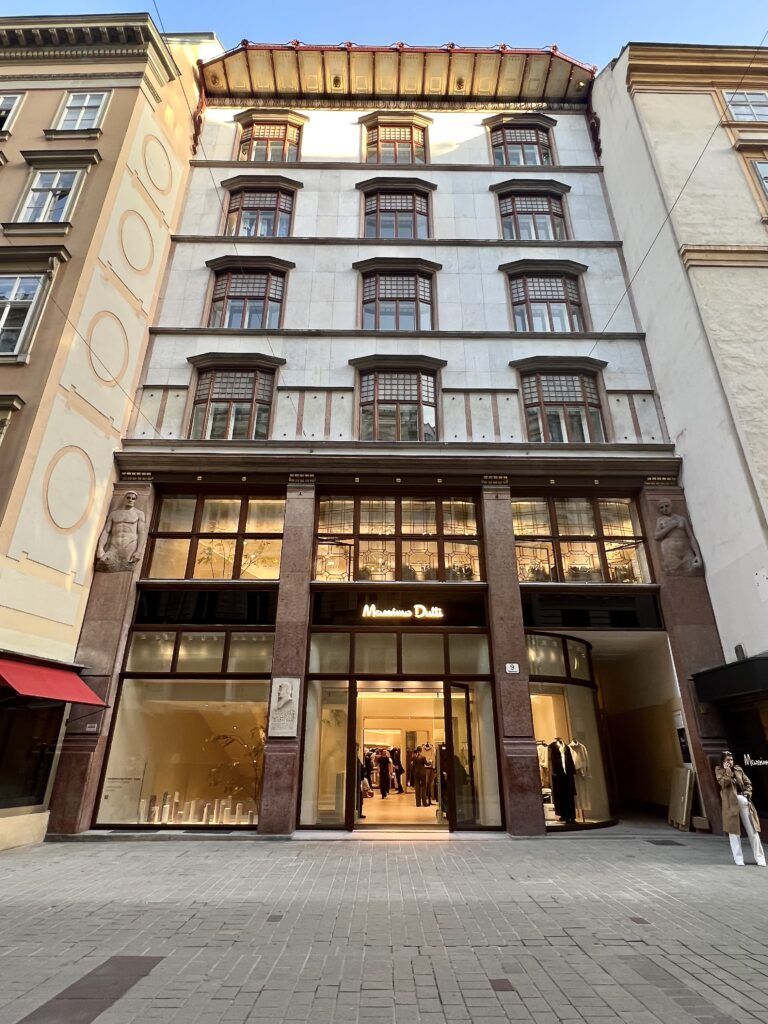
Ataria House
This arresting building was built by Wagner’s student Max Fabiani between 1900 and 1902. Fabiani, known for his distinctive architectural style, later became the art advisor to Franz Ferdinand, the heir to the Austro-Hungarian throne.
His approach to design reflects a remarkable individualism, capturing the zeitgeist of the era without merely following fashion.
Fabiani’s talent for typological innovation was especially crucial for this particular building project, given the unique challenges of the property’s plot.
The facade combines sturdy iron crossbeams and elegant Carrera marble with eye-catching bay windows. At the top, an umbrella-like canopy is a distinctive feature. It’s echoed on a smaller scale on the windows.
This blend of materials and design elements not only addresses the architectural challenges but also creates a bold aesthetic statement.
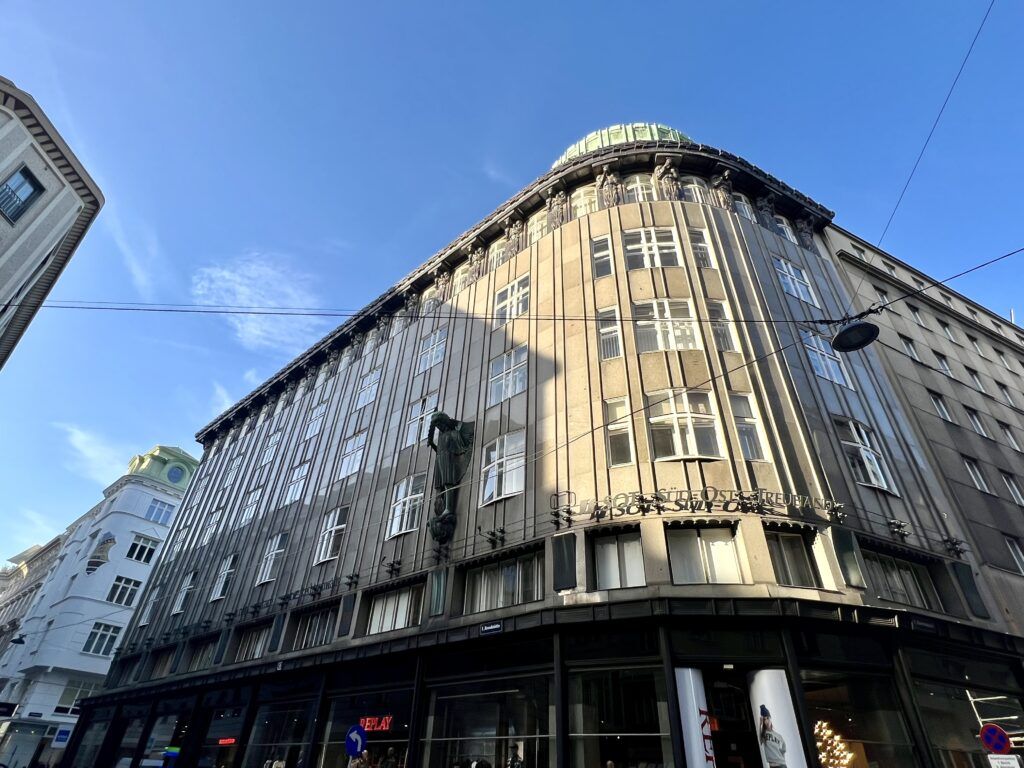
Zacherl House
The Zacherl House in Vienna was designed by Joze Plečnik, an architect renowned for his work in Ljubljana Slovenia. This building is truly one of Vienna’s most impressive Art Nouveau facades.
Plečnik’s design is notable for its use of vertical slabs of polished granite. They elegantly cover the concrete structure and complement the arrangement of the windows.
The facade is further enhanced by rows of Atlas figures that seem to support the cornice, adding a dramatic flair to the structure. The building is also adorned with a large sculpture of the Archangel Michael.
Inside, the building features a long, windowless corridor that opens into a grand staircase, topped with an extravagant chandelier.
At the time of its construction, the Zacherl House was controversial. But eventually came to be embraced by the avant-garde community for its distinctive style.
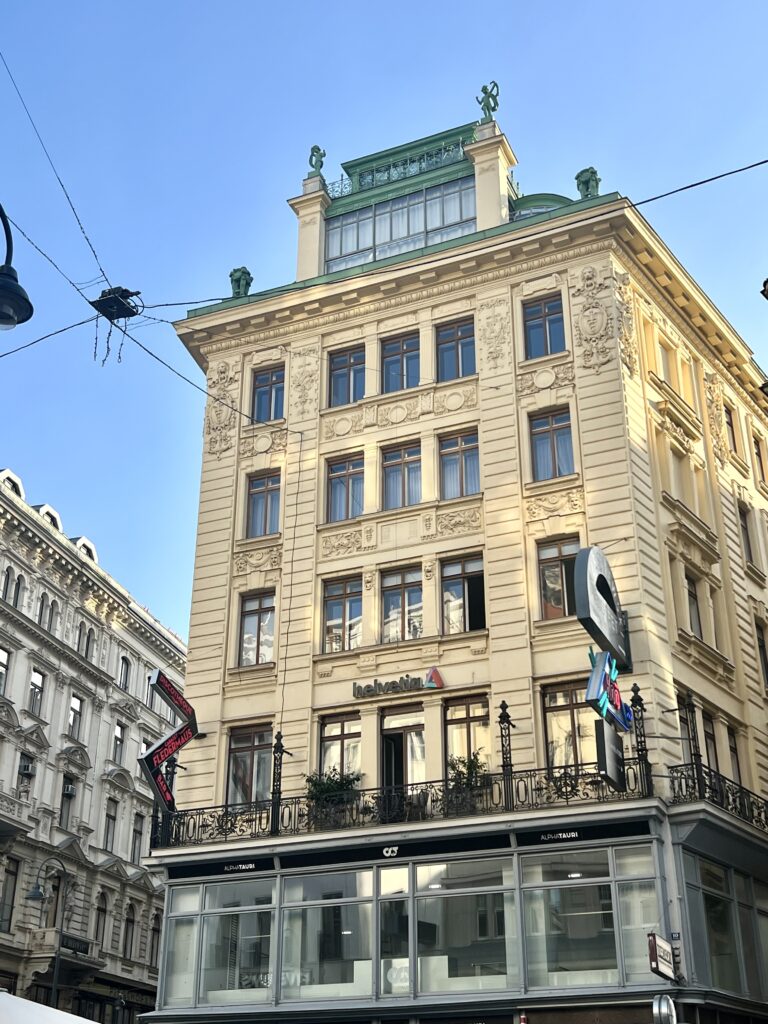
Anker House
Anger House is right on Graben Street. Otto Wagner designed it for the Anker Insurance Company in 1894-95.
The facade is elegant, but restrained, with subtle ornamental ironwork. Wagner maximized the window surfaces. And, at the base, is a glass and iron cage in front of load bearing piers.
At the top is a gorgeous attic studio of glass and green iron, which was a major contribution to the concept of a roofscapes. A mini terrace is topped on the sides with two sculptures.
Tip: Also on Graben, for more Art Nouveau, you can check out the Knize tailor shop, the Braun & Co. store, and the Altman & Kuhne confectioners shop.
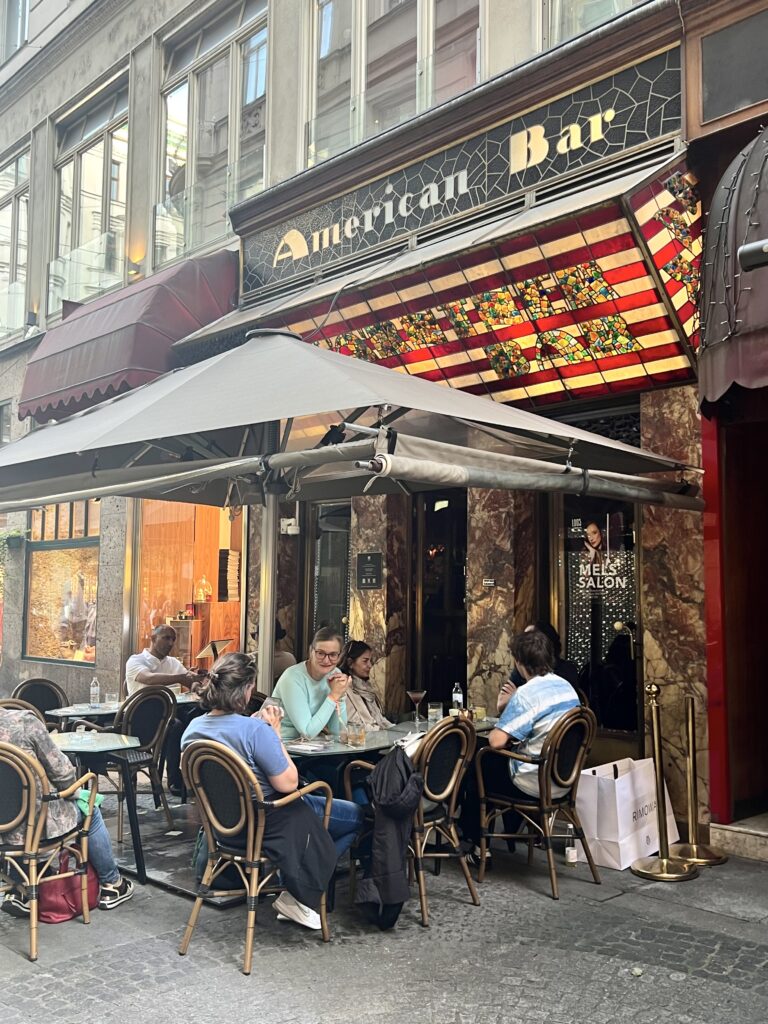
American Bar
The American Bar, also known as the Loos Bar, is celebrated for its exquisite Art Nouveau interior.
Designed by the famed Adolf Loos in 1908, this tiny bar is a jewel of early modern architecture. It’s just 13, x 20 feet.
The facade has four columns of Skyros marble. Above the door, you’ll see a canopy lit from the interior with a stylized version of the American flag.
Inside, Loos uses mirrors and clean lines to create an illusion of space. The interior is decked out in luxurious materials like onyx, marble, brass, and mahogany, reflecting the opulence typical of Art Nouveau design.
This kind of bar, based on American models with few seats, became an overnight sensation in Vienna.
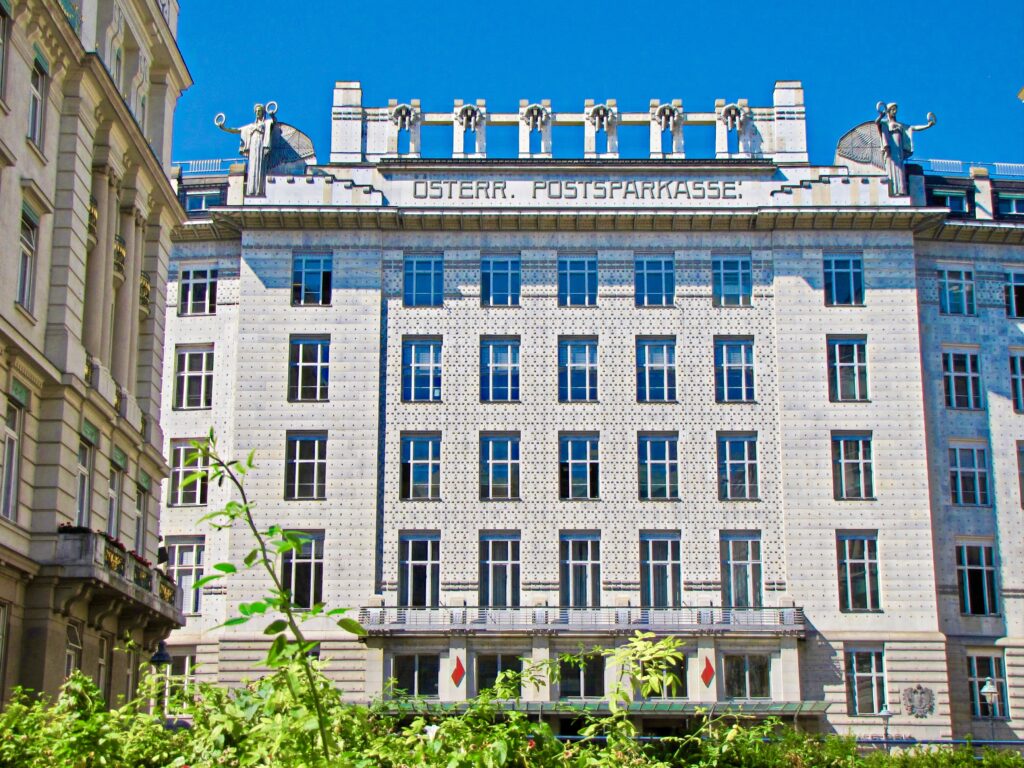
Postal Savings Bank
Completed in 1906, the Postal Office Savings Bank is a perfect example of Viennese Art Nouveau, where practical design meets artistic elegance. It’s one of the great modern buildings of the century.
The architect, Otto Wagner, opted for a futuristic fusion of glass, iron, aluminum, and marble.
The building’s design, focusing on functionality, gives it a unique appearance. It almost resembles a safe or a hammered chest.
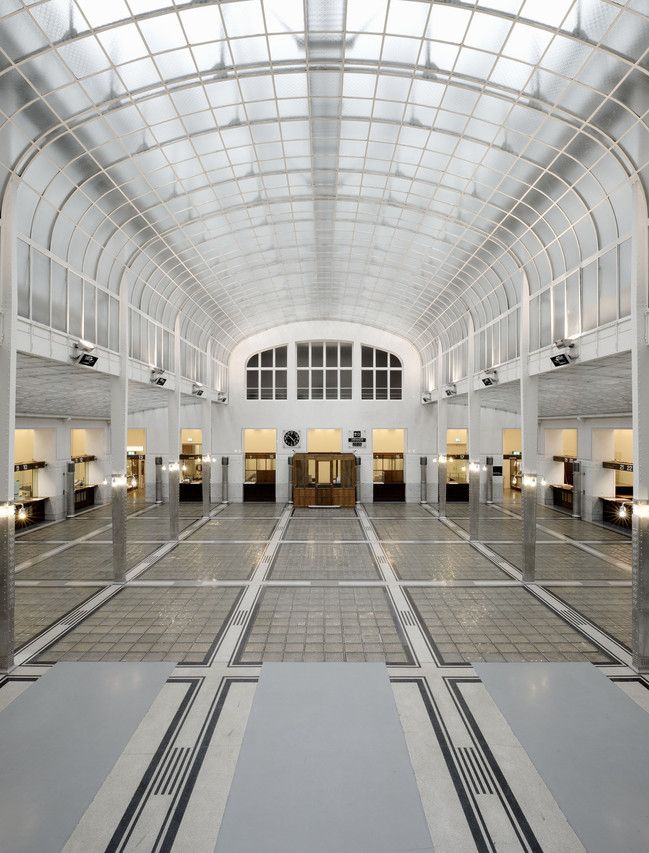
While you’ll find some metalwork, floral patterns, and decorative iron grilles, these elements are used sparingly, highlighting Wagner’s less-is-more approach.
A distinctive feature of the building is the statues of Hermes and Fortuna at the roof corners. These figures represent commerce and fortune, fittingly adorning this financial institution.
You can walk inside too. The bank has an impressive three-nave glass hall, echoing the style of a basilica. You can still see traces of the original Art Nouveau decorations.
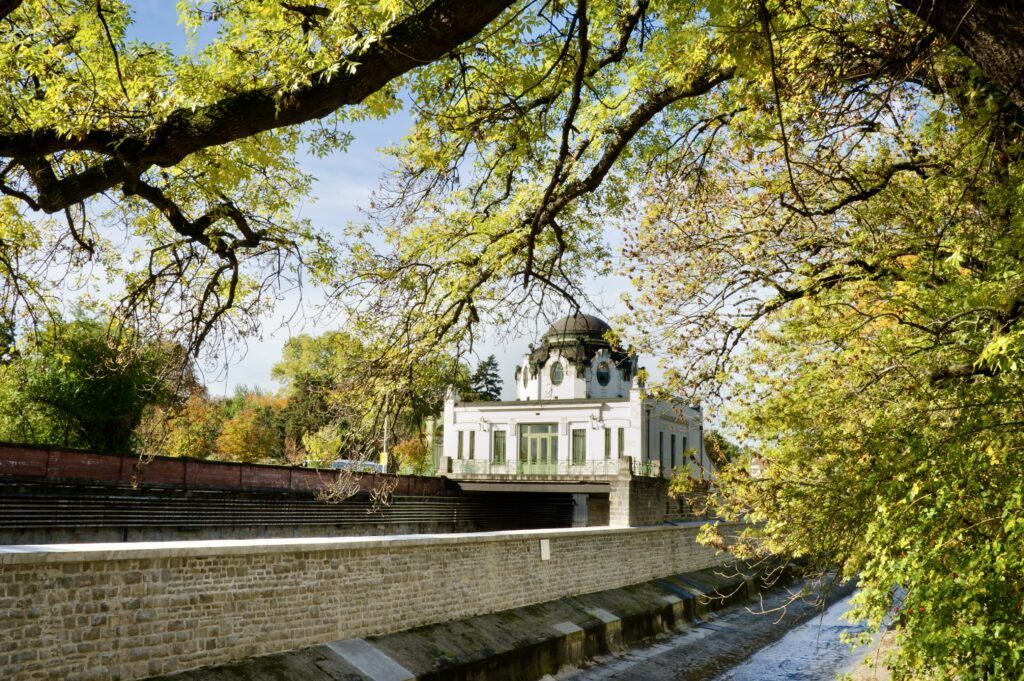
Hofpavilion Hietzing
Designed by Wagner, this Art Nouveau pavilion was specifically built for the use of the imperial family.
Constructed in 1899, it served as a private waiting area and station for Emperor Franz Joseph I and members of the imperial court when they were traveling to and from Schönbrunn Palace.
The pavilion has an elegant design, ornamental details, and the use of high-quality materials, all characteristic of Wagner’s style.
Today, the Hofpavillon Hietzing is open to the public as a museum, allowing visitors to appreciate its historical significance and architectural beauty.
Tip: You can combine this with a visit to Schönbrunn Palace, just minutes away.
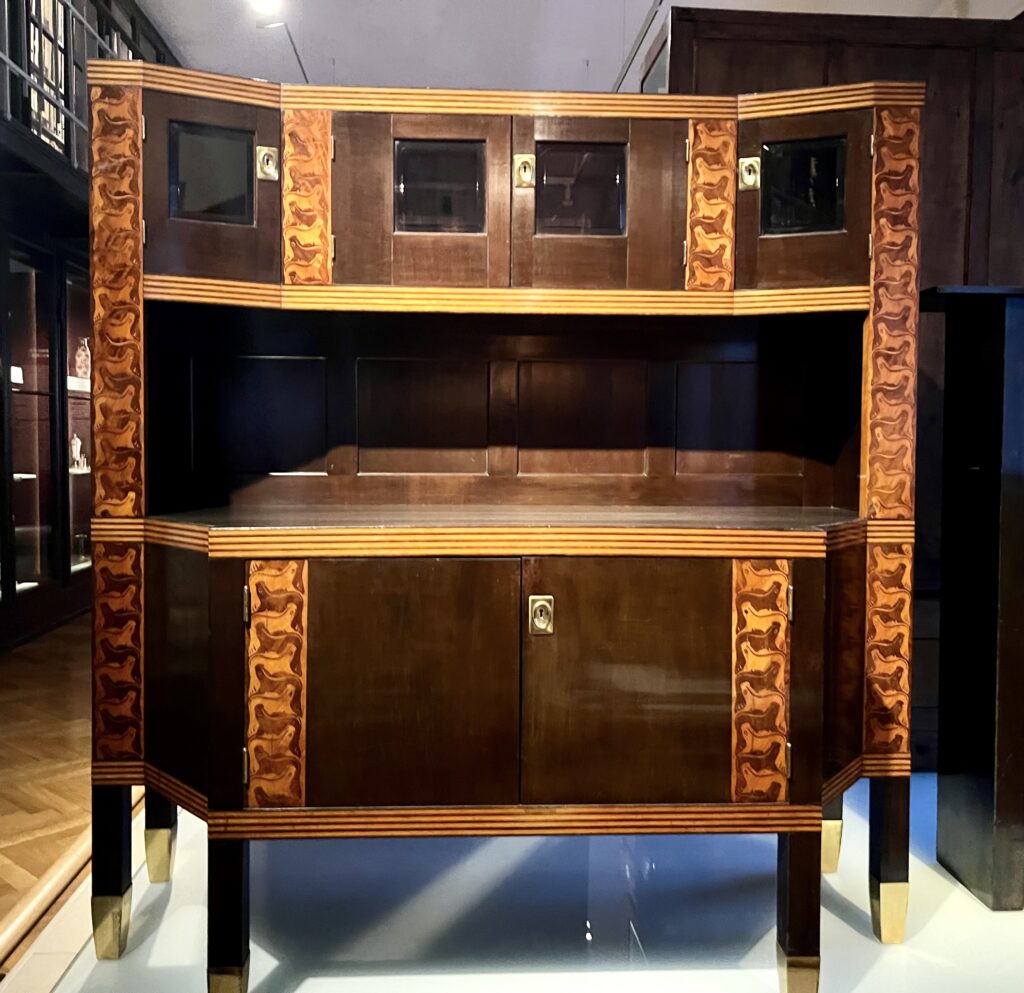
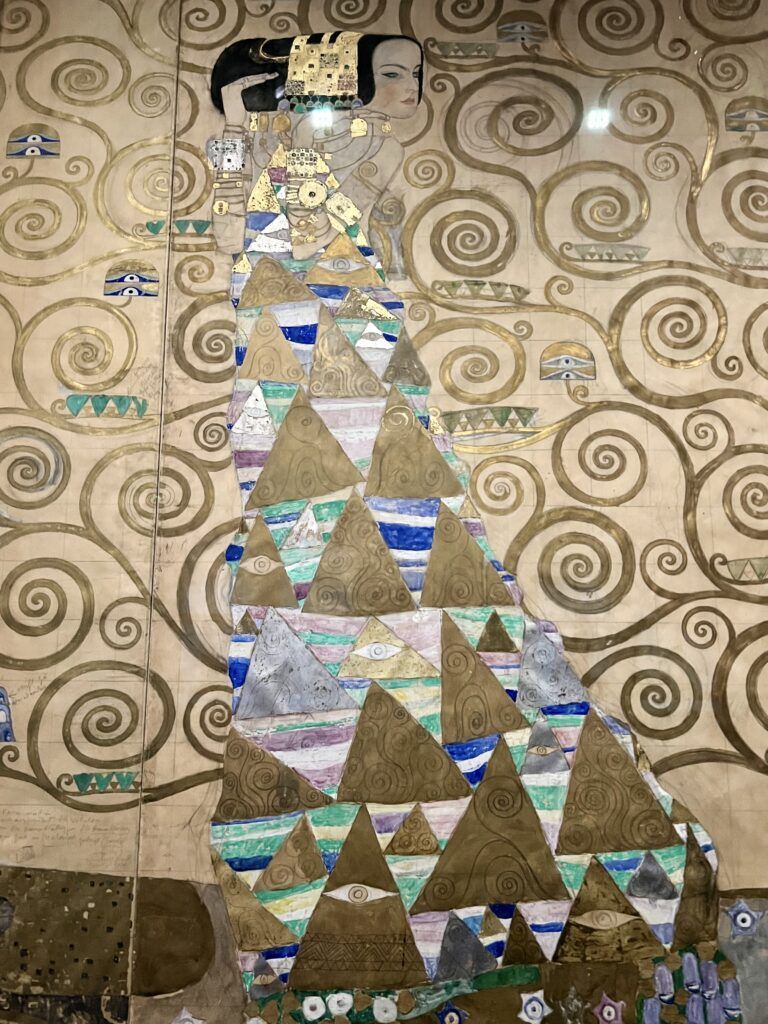
MAK Museum
The MAK Museum in Vienna, although not an Art Nouveau building itself, houses an impressive array of Art Nouveau art and furniture, particularly in the Vienna 1900 exhibit.
This collection features works by notable artists and designers such as Gustav Klimt, Josef Hoffmann, and Koloman Moser.
One of the most significant item in the collection are Gustav Klimt’s preparatory designs, or cartoons, for the Stoclet Frieze. These were created between 1905 and 1911, during Klimt’s celebrated golden period.
Adolph Stoclet, a wealthy Belgian financier, commissioned Klimt to create these designs for the dining room of his mansion in Brussels.
Displayed behind glass, the cartoons give us a fascinating insight into Klimt’s creative process. Visitors can admire the intricate spiraling patterns, the portrayal of the Tree of Life, and beautifully rendered scenes like a young girl in a meadow and a couple embracing.
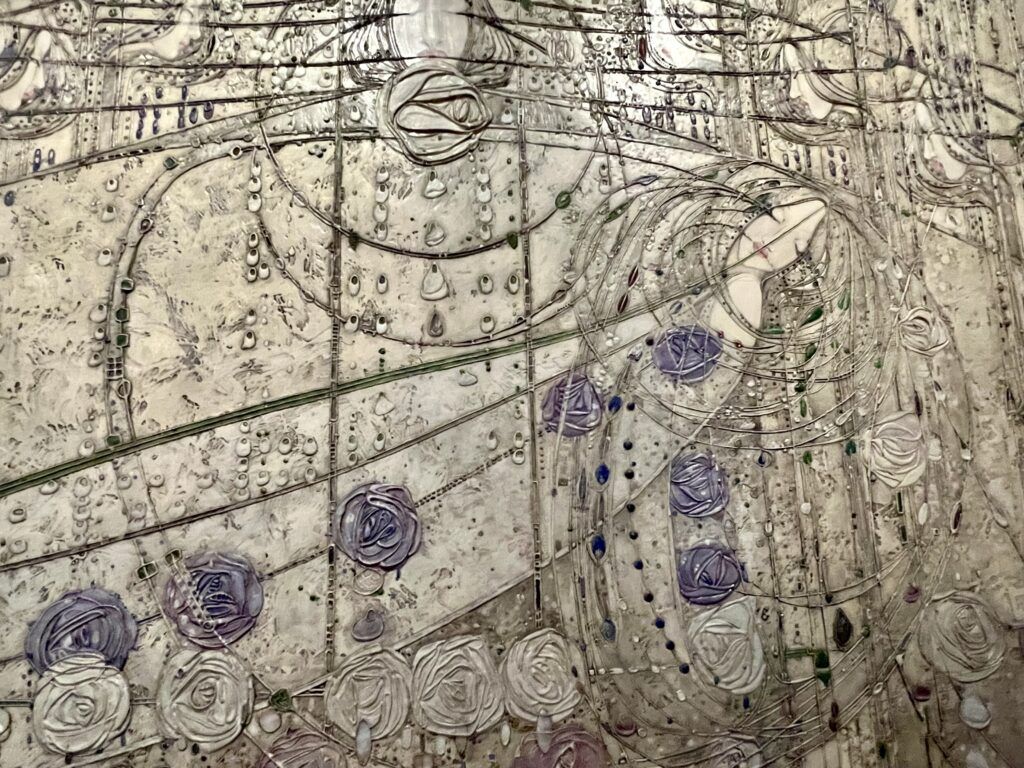
These designs are rich and sensual, and feature enamel, mother of pearl, and gold leaf.
I hope you’ve enjoyed my guide to Vienna’s beautiful Art Nouveau buildings. You may find these other Vienna travel guides useful:
- 1 day in Vienna itinerary
- 3 days in Vienna itinerary
- 4 days in Vienna itinerary
- Tips for Visiting Vienna
- Best Museums in Vienna
- Beautiful Churches in Vienna
- Guide to the Hofburg Palace
- Guide to the Belvedere Palace
- Is Mozarthaus Worth Visiting?
- Things To Do in Vienna in Winter
Pin it for later.

